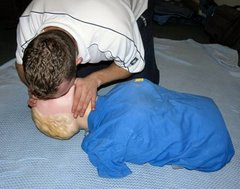Head Injuries 2: COMPRESSION
Recognition:
- Probably (but not always) a history of head injury.
- Deteriorating level of response - casualty may become unconscious.
Possibly:
- Intense headache.
- Noisy breathing, becoming slow.
- Slow, yet full and strong pulse.
- Unequal pupil size.
- Weakness or paralysis down one side of the face or body.
- High temperature and flushed appearance.
- Drowsiness.
- Change of personality such as irritability or confusion.
Aim:
Treatment:
- Get urgent medical attention for the casualty
Treatment:
- Dial for an ambulance immediately.
- Monitor the casualty's level of responsiveness, breathing and pulse.
- Open and maintain the casualty's airway if necessary.
- Be prepared to give resuscitation if the casualty stops breathing.
DO NOT allow the casualty to eat, drink or smoke.
COMPRESSION NEEDS URGENT MEDICAL ATTENTION - SUMMON HELP IMMEDIATELY.
COMPRESSION NEEDS URGENT MEDICAL ATTENTION - SUMMON HELP IMMEDIATELY.




